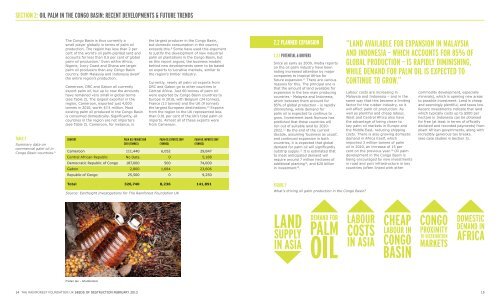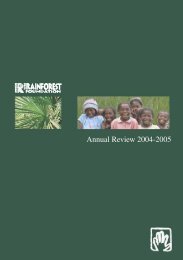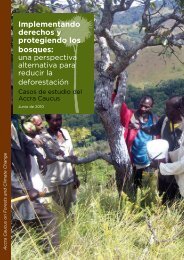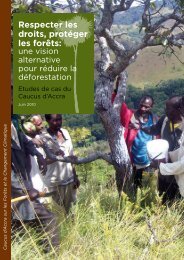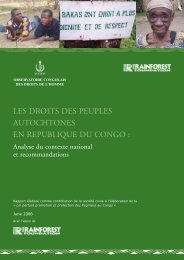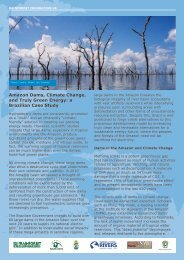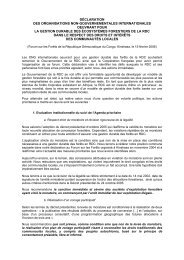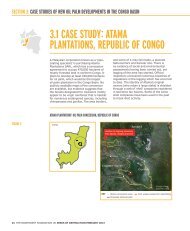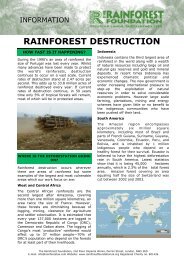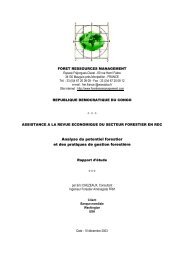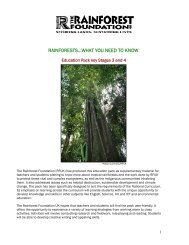Seeds of Destruction - Rainforest Foundation UK
Seeds of Destruction - Rainforest Foundation UK
Seeds of Destruction - Rainforest Foundation UK
Create successful ePaper yourself
Turn your PDF publications into a flip-book with our unique Google optimized e-Paper software.
SECTION 2: OIL PALM IN THE CONGO BASIN: RECENT DEVELOPMENTS & FUTURE TRENDS<br />
TABLE 2<br />
Summary data on<br />
commercial palm oil in<br />
Congo Basin countries. 9<br />
The Congo Basin is thus currently a<br />
small player globally in terms <strong>of</strong> palm oil<br />
production. The region has less than 2 per<br />
cent <strong>of</strong> the world’s oil palm-planted land and<br />
accounts for less than 0.5 per cent <strong>of</strong> global<br />
palm oil production. 7 Even within Africa,<br />
Nigeria, Ivory Coast and Ghana are larger<br />
palm oil producers than any Congo Basin<br />
country. Both Malaysia and Indonesia dwarf<br />
the entire region’s production.<br />
Cameroon, DRC and Gabon all currently<br />
export palm oil, but up to now the amounts<br />
have remained very small in global terms<br />
(see Table 2). The largest exporter in the<br />
region, Cameroon, exported just 4,000<br />
tonnes in 2010, worth $7.4 million. Most<br />
existing palm oil produced in the Congo Basin<br />
is consumed domestically. Significantly, all<br />
countries in the region are net importers<br />
(see Table 2). Cameroon, for instance, is<br />
COUNTRY<br />
PALM OIL PRODUCTION<br />
2010 (TONNES)<br />
the largest producer in the Congo Basin,<br />
but domestic consumption in the country<br />
exceeds this. 8 Some have used this argument<br />
to justify the development <strong>of</strong> new industrial<br />
palm oil plantations in the Congo Basin, but<br />
as this report argues, the business models<br />
behind new developments seem to be based<br />
on exports to lucrative markets, similar to<br />
the region’s timber industry.<br />
Currently, nearly all palm oil exports from<br />
DRC and Gabon go to other countries in<br />
Central Africa. Just 60 tonnes <strong>of</strong> palm oil<br />
were exported by Congo Basin countries to<br />
Europe in 2010, with Belgium (34 tonnes),<br />
France (13 tonnes) and the <strong>UK</strong> (9 tonnes)<br />
the largest European destinations. 10 Exports<br />
from the region to the <strong>UK</strong> represented less<br />
than 0.01 per cent <strong>of</strong> the <strong>UK</strong>’s total palm oil<br />
imports. Almost all <strong>of</strong> these exports were<br />
from Cameroon.<br />
PALM OIL EXPORTS 2009<br />
(TONNES)<br />
PALM OIL IMPORTS 2009<br />
(TONNES)<br />
Cameroon 111,440 6,052 29,847<br />
Central African Republic No Data 0 5,188<br />
Democratic Republic <strong>of</strong> Congo 187,000 500 74,000<br />
Gabon 2,800 1,684 23,606<br />
Republic <strong>of</strong> Congo 25,500 0 9,250<br />
2.2 PLANNED EXPANSION<br />
2.2.1 POTENTIAL & DRIVERS<br />
Since as early as 2009, media reports<br />
on the oil palm industry have been<br />
noting increased attention by major<br />
companies to tropical Africa for<br />
future expansion. 11 There are various<br />
reasons for this. The principal one is<br />
that the amount <strong>of</strong> land available for<br />
expansion in the two main producing<br />
countries - Malaysia and Indonesia,<br />
which between them account for<br />
85% <strong>of</strong> global production - is rapidly<br />
diminishing, while demand for<br />
palm oil is expected to continue to<br />
grow. Investment bank Nomura has<br />
predicted that these countries will<br />
run out <strong>of</strong> suitable land by 2020-<br />
2022. 12 By the end <strong>of</strong> the current<br />
decade, assuming ‘business as usual’,<br />
and continued expansion in both<br />
countries, it is expected that global<br />
demand for palm oil will significantly<br />
outstrip supply. 13 It is estimated that<br />
to meet anticipated demand will<br />
require around 7 million hectares <strong>of</strong><br />
additional planting 14 , and $20 billion<br />
in investment 15 .<br />
”LAND AVAILABLE FOR EXPANSION IN MALAYSIA<br />
AND INDONESIA – WHICH ACCOUNTS FOR 85% OF<br />
GLOBAL PRODUCTION – IS RAPIDLY DIMINISHING,<br />
WHILE DEMAND FOR PALM OIL IS EXPECTED TO<br />
CONTINUE TO GROW.”<br />
Labour costs are increasing in<br />
Malaysia and Indonesia – and in the<br />
same way that this became a limiting<br />
factor for the rubber industry, so it<br />
will affect palm oil production. As<br />
well as plentiful and cheap labour,<br />
West and Central Africa also have<br />
the advantage <strong>of</strong> being closer to<br />
key palm oil markets in Europe and<br />
the Middle East, reducing shipping<br />
costs. There is also growing domestic<br />
demand in Africa itself, which<br />
imported 3 million tonnes <strong>of</strong> palm<br />
oil in 2010, an increase <strong>of</strong> 15 per<br />
cent on the previous year. 16 Oil palm<br />
development in the Congo Basin is<br />
being encouraged by new investments<br />
in road and port infrastructure in key<br />
countries (<strong>of</strong>ten linked with other<br />
commodity development, especially<br />
minerals), which is opening new areas<br />
to possible investment. Land is cheap<br />
and seemingly plentiful, and taxes low.<br />
Recent investments indicate that land<br />
which typically costs up to $500 per<br />
hectare in Indonesia can be obtained<br />
for free (at least in terms <strong>of</strong> <strong>of</strong>ficially<br />
declared and recorded payments) from<br />
pliant African governments, along with<br />
incredibly generous tax breaks.<br />
(see case studies in Section 3).<br />
Total 326,740 8,236 141,891<br />
Source: Earthsight Investigations for The <strong>Rainforest</strong> <strong>Foundation</strong> <strong>UK</strong><br />
FIGURE 2<br />
What’s driving oil palm production in the Congo Basin?<br />
Tristan tan - Shutterstock<br />
14 THE RAINFOREST FOUNDATION <strong>UK</strong> SEEDS OF DESTRUCTION FEBRUARY 2013 15


